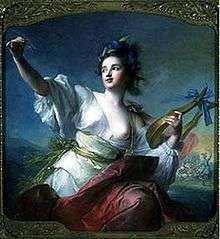Terpsichore
For other uses, see Terpsichore (disambiguation).
_01.jpg)

Terpsichore, Muse of Music and ballet, an oil on canvas painting by Jean-Marc Nattier (1739).
In Greek mythology, Terpsichore (/tərpˈsɪkəriː/; Τερψιχόρη) "delight in dancing" was one of the nine Muses and goddess of dance and chorus.[1] She lends her name to the word "terpsichorean" which means "of or relating to dance". She is usually depicted sitting down, holding a lyre, accompanying the ballerinas' choirs with her music. Her name comes from the Greek words τέρπω ("delight") and χoρός ("dance"). She is also a mother of the sirens and Parthenope
Historical references
- Terpsichore figures among her sisters in Hesiod's Theogony.
- When The Histories of Herodotus were divided by later editors into nine books, each book was named after a Muse. Terpsichore was the name of the fifth book.
Modern references
- 1961 TV Gunsmoke S7/ep. 02 "Old Yellow Boots", at a dance party, Doc (Milburn Stone) boasts to Chester (Dennis Weaver) that in his younger days he was known as "the terror of Terpsichore"
- In the Fred Astaire/Ginger Rogers feature film Swing Time (1936), Lucky (Astaire), when asked by Mr. Gordon, why he wishes to learn to dance, answers: "To flirt with terpsichory". He then proceeds to take a dance lesson with Penny (Rogers), culminating in a paired tap routine.
- "Terpsichore" is the title of a large collection of dance tunes collected by Michael Praetorius, some originating with Pierre-Francisque Caroubel.
- In an episode called "Quick-Quick Slow Death" of the UK crime agent series The Avengers, a dance institute is called Terpsichorean Training Techniques Inc.
- The fifth season episode of Xena: Warrior Princess Lyre, Lyre, Hearts on Fire centers around a battle of the bands for Terpsichore's Lyre.
- Terpsichore is also found in François Couperin's "Second Ordre" from the Pièces de clavecin.
- Terpsichore is also found in the third version (HWV 8c) of Handel's opera Il pastor fido (1712). This opera is sometimes referred to as Terpsicore and Il pastor fido.
- The eighteenth century French dancer and courtesan Marie-Madeleine Guimard named the private theater in her private palace (1766) the Temple of Terpsichore.
- British 32-gun frigate HMS Terpsichore (1785) commanded by Captain Bowen participated in the Battle of Santa Cruz de Tenerife (1797).
- In the 1947 film Down To Earth Rita Hayworth plays Terpsichore, who is annoyed and visits Earth to change a musical that depicts her in a bad light.
- T.S. Eliot in the poem 'Jellicle Cats' from Old Possum's Book of Practical Cats (1939), refers to the 'terpsichorean powers' of Jellicle Cats as they dance by the light of the Jellicle Moon.
- In the film McLintock! Drago introduces an exhibition of new dance steps as Terpsichorean.
- Olivia Newton-John plays the muse Terpsichore as Kira in the 1980 film Xanadu.
- Terpsichore in Sneakers is the title of a 1980 study of postmodern dance by dance historian and critic Sally Banes.
- The Russian singer Origa sings a song, "Tersicore".
- The Terpsichorean Muse is referred to by John Cleese in the Cheese Shop sketch of Monty Python's Flying Circus.
- The Jimmy Van Heusen/Sammy Cahn song "Come Dance with Me" (popularized by Frank Sinatra) includes the lyric "what an evening for some Terpsichore." However it is sung as a three-syllable word with the "chore" component pronounced like "core" (to rhyme with "for") rather than "curry".
- Terpsichore is a technique used by the royal guard Neferpitou to "dance past one's limits" in the manga Hunter × Hunter.
- In the Les Luthiers' Unen canto con humor comedy show is referred in a sketch by Daniel Rabinovich and Marcos Mundstock, but Daniel improperly pronounces her name, calling her "Esther Píscore".
- On the album Istoria ~Musa~, J-Pop and World singer Shikata Akiko sings "Terpsichora," a dedication song to the goddess.
- Terpsichore is also the name of a street in New Orleans' historic neighborhoods of Faubourg Lafayette and the Lower Garden District. It runs alongside Euterpe and Melpomene streets, also named for Greek muses.
- Terpsichorean is also the name of the Choreography Society of Hansraj College, University of Delhi, India.
- Terpischore "Choral Dance" is the name of a chapter in Theresa Cha's Dictee.
- Reference "Oh Terpsichore" in Nuala ni Dhomhnaill's poem "Cathleen"
- "Some Terpsichore" is the title of a short story in a 2014 book, Thunderstruck and Other Stories, by Elizabeth McCracken.
- Gob has a song called Terpsichore on their album Apt. 13
- Terpsichore is one of the legendary "Mythic Weapons" obtainable in Final Fantasy XI, only equipped by the Dancer class.
- The Onyx Terpsichore is a weapon of the Hunting Horn class in 2015's Monster Hunter 4 Ultimate for Nintendo 3DS.
- Wilkins Micawber, Esq, Jr is described as a 'votary of Terpsichore' in an Australian newspaper brought to London by Dan Peggotty in David Copperfield by Charles Dickens.
- The album Cool by Bob James and Earl Klugh features a track called "Terpsichore".
See also
- Muse
- Muses in popular culture
- The asteroid 81 Terpsichore
References
- ↑ Theoi Project, Greek Mythology, Muses , Retrieved April 29, 2014
External links
 Media related to Terpsichore at Wikimedia Commons
Media related to Terpsichore at Wikimedia Commons- Facebook Page for Terpsichore
- Warburg Institute Iconographic Database (ca 40 images of Terpsichore)
| ||||||||||||||||||||||||||||||||||||||||||||||||||||||||||||||||||||||||||||||||||||||||||||||||||
|
This article is issued from Wikipedia - version of the Thursday, February 04, 2016. The text is available under the Creative Commons Attribution/Share Alike but additional terms may apply for the media files.